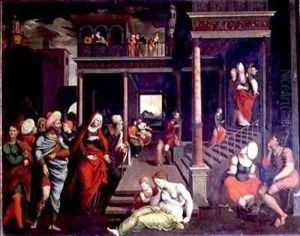Jeronimo Cosida y Ballejo Paintings
Jeronimo Cosida, also known as Jerónimo Cósida or Hieronymus Custodis, was a Spanish painter and art theorist from the Renaissance period. Born around 1510 in Zaragoza, Spain, he became one of the notable figures of the Aragonese school of painting. Not much is known about his early life or training, but it is believed that he may have been a disciple of the Italian mannerist painter Parmigianino, which is suggested by the stylistic influences in his work.
Cosida's oeuvre includes religious compositions, altarpieces, and portraits. His style is characterized by a blend of Italian Mannerism's grace and elegance with the religious devotion typical of Spanish art of the time. His most famous work is 'El libro de la invención liberal y arte del juego del axedrez' (The Book of the Liberal Invention and Art of the Game of Chess), which is a treatise on chess that also includes a series of his own engravings.
During his career, Cosida held various positions of esteem. He served as a court painter to the Spanish nobility and produced works for several religious institutions. While his paintings were well-regarded, it was his theoretical work on art that had a lasting impact. In particular, his treatise on the proportions of the human body, influenced by the works of Vitruvius and Leonardo da Vinci, became a reference for Spanish artists of the time.
Jeronimo Cosida died in 1571, leaving behind a legacy that was particularly influential in Aragon and beyond. His works are preserved in various Spanish institutions, including the Museo del Prado in Madrid, though he is not as widely known today as some of his contemporaries. His contributions to art theory and his position as a court painter make him a notable figure in the history of Spanish Renaissance art.
